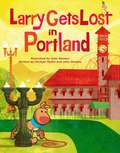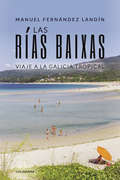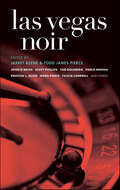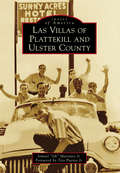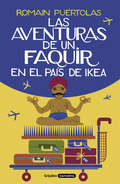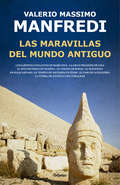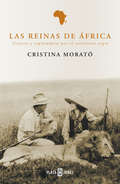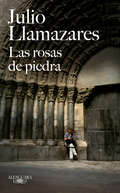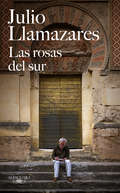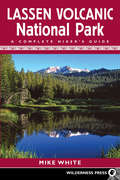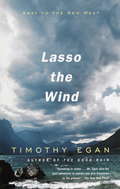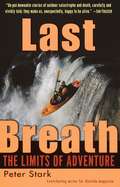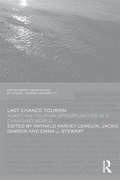- Table View
- List View
Larry Gets Lost In Portland
by John Skewes Michael MullinIn Larry the adorable pooch's latest adventure, he goes on vacation with Pete and the family to Portland, Oregon. As usual, in hot pursuit of a tempting treat, he gets separated from the family and frantically tries to find them again. Along the way he discovers some of the city's most fun and interesting landmarks and cultural attractions, including the waterfront, the zoo, the Portland Art Museum, Hawthorne Bridge, Old Town, and the Park Blocks.
Larry's Kidney: Being the True Story of How I Found Myself in China with My Black Sheep Cousin and His Mail-Order Bride, Skirting the Law to Get Him a Transplant—and Save His Life
by Daniel Asa Rose“One of the funniest, most touching and bizarre nonfiction books I’ve read.”—Boston GlobeLarry’s Kidney is Daniel Asa Rose’s wild-and-crazy memoir about his trip to Beijing, China, to help his black-sheep cousin Larry receive an illegal kidney transplant, collect a mail-order bride, and stop a hit-man from killing their uncle. An O. Henry Prize winner, a two-time recipient of PEN Fiction Awards, and a 2006 National Endowment for the Arts Literary Fellow, Rose has written “a surprisingly fun, and moving, book with resonance” (Chicago Tribune).
Las Aventuras de Tamarita Rachel
by Andrea Gardiner Alfieri Louvier SilvaReconocimientos para “Las Aventuras de Tamarita Rachel”; “Andrea es una misionera médica en el Ecuador. Los niños leerán fascinados las aventuras del libro, pero también aprenderán las diferencias que tienen en su forma de vida los niños de países más pobres del mundo. Es una presentación bien gestionada de los problemas de dichos niños; un sensibilizador respecto a la pobreza infantil.” Jennifer Rees Larcombe, Autora, Conferencista.
Las Rías Baixas: Viaje a la Galicia tropical
by Manuel Fernández LandínViaje a la Galicia tropical. Guía total de las Rías Baixas, una tierra volcada al mar como ninguna otra del continente europeo. <P><P>Sus páginas te ayudarán a conocer la Galicia tropical, donde el mar huele a mar y el bosque a bosque; tras visitar sus ríos y rías, sus pueblos y aldeas, sus paradisíacas islas y maravillosas playas; descubrir los múltiples vestigios que se conservan de los pueblos que en ella se asentaron: preceltas, celtas, romanos, judíos, suevos y catalanes; subir al Olimpo celta en el que podrás llenar los pulmones de un aire puro, mágico; disfrutar de su rica gastronomía: carnes, pescados, mariscos y excelentes vinos que te servirán en restaurantes, tabernas o en una feria, verbena o típica romería gallega. <P><P>Por fin, el libro que te orientará en una Galicia en muchos aspectos poco conocida, incluso para muchos gallegos. Incluye mapa de carreteras e información sobre hoteles, campings o autocaravanas. Oficinas de turismo. Museos. Bibliotecas y Centros de documentación.
Las Vegas Noir (Akashic Noir #0)
by Jarret Keene, Todd James PierceIn this chilling portrait of America's Sin City, lady luck is just as likely to dispense cold hard cash as a cold-hearted killing. Akashic Books continues its groundbreaking series of original noir anthologies, launched in 2004 with Brooklyn Noir. Each story is set in a distinct neighborhood or location within the city of the book. Brand-new stories by: John O’Brien, David Corbett, Scott Phillips, Nora Pierce, Tod Goldberg, Bliss Esposito, Felicia Campbell, Jaq Greenspon, José Skinner, Pablo Medina, Christine McKellar, Lori Kozlowski, Vu Tran, Celeste Starr, Preston L. Allen, and Janet Berliner.From the introduction by Jarret Keene & Todd James Pierce:“‘Ooh, Las Vegas,’ sang the pioneering country-rocker Gram Parsons. ‘Every time I hit your Crystal City, you know you’re gonna make a wreck out of me.’ As Las Vegans, we regularly read about these wrecked lives in newspapers and magazines. We routinely observe people going about their wildly destructive antics on mainstream TV. Often we can’t believe these stories are unfolding in our city. They almost seem like put-ons, elaborate pranks borrowed from atrocious cut-rate screenplays. But there they are, these inhabitants of our city, their mug shots staring us down, making us wonder if what Parsons said is really true—that in Las Vegas your only real friend is the queen of spades . . ."The stories gathered in Las Vegas Noir are written by longtime residents and avid chroniclers of Sin City, authors who take you far beyond the neon of Caesars Palace and into the neighborhoods too dangerous for CSI. Absolutely cliché-free, these stories are full of flesh-and-blood characters trapped in dire circumstances that only real Las Vegas neighborhoods can spring."
Las Villas of Plattekill and Ulster County (Images of America)
by Tito Puente Jr. Ismael Ish" Martinez Jr.This is the first comprehensive historical retrospective on Las Villas of Plattekill and Ulster County ever written. Ulster County was first settled in 1652 and officially became a county in 1683. Its rural nature, scenic beauty, and the Catskill Mountains have made it a popular vacation destination since the 19th century. Described in numerous news articles as the Spanish Alps, Las Villas, as they were collectively known, was a lively enclave of Spanish, Puerto Rican, and other Hispanic summer resorts in Plattekill, New York, and the Catskill Mountains. Starting in the 1920s and for the next 60 years, the area became the most popular vacation destination for Latinos in the Northeast, with an emphasis on music, food, language, and customs.
Las aventuras de un faquir en el país de Ikea
by Romain PuértolasUna ingeniosa historia donde la brújula se volverá loca con las correrías de un estrafalario faquir. Una vivaz y tierna comedia filosófica sobre un mundo que, como un armario de Ikea, está lleno de falsas puertas y dobles fondos. Tras alcanzar la fama con un libro donde relataba sus aventuras al quedarse atrapado en un armario de Ikea, el faquir Dhjamal Mekhan Dooyeghas se ha aburguesado. Vive más como un marajá que como un verdadero faquir, y así se lo hace notar su editor, quien le recrimina que su nueva novela ha perdido autenticidad. <P><P> Dhajamal se da cuenta entonces que, para escribir historias originales, lo primero que tiene que hacer es recuperar su propia esencia. Así que decide cambiar las sábanas de seda que utiliza ahora por la mítica cama de clavos de Ikea, la Miskavlospikån, ¡pero resulta que está descatalogada! <P><P> Dhjamal no se da por vencido y toma un avión a Suecia para convencer al fundador de Ikea de que vuelvan a fabricar ese modelo de cama de clavos embarcándose así en una nueva y rocambolesca aventura que le ayudará a reencontrarse consigo mismo. Este increíble viaje le recordará las peripecias de cuando recorrió toda Europa como inmigrante ilegal al tiempo que le traerá a la memoria viejos recuerdos de su dura infancia como humilde aprendiz de faquir en Bombay.
Las maravillas del mundo antiguo
by Valerio Massimo ManfrediUn fascinante recorrido por las maravillas del mundo antiguo, sus secretos, la realidad y las leyendas que las han acompañado, de la mano del Manfredi arqueólogo, apasionado por su profesión, riguroso y excelente divulgador. Los jardines que un rey hizo construir para su amada. Una tumba desmesurada para un solo hombre. Un dios con carne de marfil y ropajes de oro, sentado en su trono. Una estatua de bronce de treinta y dos metros de altura, el desafío de un discípulo a su inalcanzable maestro. El espectacular sepulcro rodeado de columnas de un reyezuelo presuntuoso. El templo más grande jamás construido, erigido para la diosa. Una torre en una islita cuya luz guiaba a los navegantes desorientados en la noche. Los jardines colgantes de Babilonia, la gran pirámide de Guiza, el Zeus de Fidias, el coloso de Rodas, el mausoleo de Halicarnaso, el templo de Artemisa y el faro de Alejandría. Son las obras más impresionantes de la Antigüedad, el orgullo de las grandes civilizaciones del pasado, que aún hoy encienden nuestra imaginación. A ellas Manfredi suma otra, menos conocida e igualmente excepcional: la tumba-santuario de Antíoco I en la cima de una montaña de Turquía. Valerio Massimo Manfredi es internacionalmente conocido como el gran autor de novela histórica sobre el mundo antiguo. Entre sus títulos más conocidos están la trilogía Aléxandros, La última legión, El tirano, El imperio de los dragones,El ejército perdido, Los idus de marzo, Odiseo. El juramento y Odiseo. El retorno. Pero Manfredi también es arqueólogo, especializado en arqueología clásica. Ha impartido clases en universidades de Italia y de otros países. Ha conducido numerosas excavaciones y ha publicado artículos y ensayos académicos, además de colaborar en periódicos y revistas. Ha escrito y dirigido documentales sobre la Antigüedad para las cadenas más importantes de televisión. Toda esta enorme dedicación a un tema que le apasiona se concentra ahora en Las maravillas del mundo antiguo, donde nos invita a viajar por la Historia y a conocer a quienes la vivieron y la estudian. Reseña:«Una narración poderosa y magnética que ofrece la posibilidad de visitar con los ojos de la mente esas maravillas, esas obras que desafiaban lo imposible.»Modena Today
Las montañas de la mente: Historia de una fascinación
by Robert MacfarlaneRobert Macfarlane nos invita a subir la mirada hacia las montañas, en este apasionante viaje cultural por la historia de nuestra fascinación por ellas. Galardonado con The Guardian First Book Award y libro del año según The New York Times. «Hay muchos libros sobre montañismo y montañeros, pero este es uno de los mejores y menos convencionales que he leído.» The Times ¿Cómo y cuándo las montañas pasaron de ser barreras peligrosas e infranqueables, habitadas por bestias y dragones, a suscitar los anhelos más aventureros de quienes se atreven a conquistarlas, incluso poniendo en riesgo sus vidas? Las montañas de la mente es un apasionante viaje cultural a través de la historia de nuestra fascinación por estas moles de piedra y hielo. Robert Macfarlane nos brinda interesantes referencias literarias e históricas que acompaña con las evocadoras descripciones de sus propios ascensos, investiga los descubrimientos geológicos y los fenómenos naturales que atrajeron a los primeros exploradores, e intenta comprender el irrefrenable deseo por lo desconocido, el poder de las alturas y las cimas a través de las ideas de aquellos personajes que, a lo largo de las décadas, contribuyeron a forjar el actual imaginario colectivo. Este libro, que es ya un clásico para los amantes de la montaña y la naturaleza, no trata, en palabras del autor, «de nombres, fechas, picos y alturas, como los libros al uso sobre la montaña, sino de sensaciones, emociones e ideas. En realidad, no es un libro sobre montañismo sino un libro sobre la imaginación». La crítica ha dicho...«Maravillosamente iluminador [...] Una estimulante combinación de aventura y academia, que demuestra una erudición deslumbrante del autor, sus agudos poderes de análisis, un pulido sentido de la historia cultural y una demostración apasionada de la dedicación con la que trata el tema.»Los Angeles Times «Fascinante, con una premisa inteligente.»The New York Times Book Review «Los montañeros de antaño se quedaron sin palabras para describir el esplendor de las montañas, pero Robert Macfarlane las encuentra.»The Times Literary Supplement «De todos los libros que se publicaron para conmemorar el 50 aniversario del ascenso al Monte Everest, Las montañas de la mente , de Robert Macfarlane, destaca por ser el libro másinteligente e interesante de lejos... con un estilo que demuestra que puede ser poético y osado a la vez.»The Economist «Un trabajo fascinante de historia y, a la vez, una meditación bellamente escrita sobre cómo la memoria, la imaginación y el paisaje de las montañas se unen en nuestras mentes y bajo nuestros pies.»Forbes «Una nueva manera de escribir sobre la exploración, supone quizá el nacimiento de un nuevo género, que no solo desafía la clasificación, si no que demanda toda una nueva categoría en sí misma.»The Telegraph
Las reinas de África
by Cristina MoratóCristina Morató viajó por primera vez a África en 1983 y desde entonces ha recorrido varios países de este continente atraída por sus gentes y la grandeza de sus paisajes. Al igual que ella un buen número de extraordinarias viajeras y exploradoras sintieron en el pasado la «llamada de África». Estas damas que en plena selva se vestían formalmente para cenar o tomaban el té de las cinco en sus tazas de porcelana, también sabían cabalgar, cazar con arco, disparar un fusil, organizar una expedición con cientos de porteadores y construir un hogar en regiones inhóspitas.Leyendo las aventuras de estas once mujeres -esposas de famosos exploradores, misioneras rebeldes, españolas de rompe y rasga, excéntricas aristócratas, apasionadas vividoras, cazadoras de elite y estrellas de cine-, nos sumergimos en un fascinante viaje por el África más legendaria.
Las reinas de África: Viajeras y exploradoras por el continente negro
by Cristina MoratóSemblanzas, anécdotas e historias de las principales viajeras que llegaron a África en los siglos XIX y XX. Cristina Morató viajó por primera vez a África en 1983 y desde entonces ha recorrido varios países de este continente atraída por sus gentes y la grandeza de sus paisajes. Al igual que ella un buen número de extraordinarias viajeras y exploradoras sintieron en el pasado la «llamada de África». Estas damas que en plena selva se vestían formalmente para cenar o tomaban el té de las cinco en sus tazas de porcelana, también sabían cabalgar, cazar con arco, disparar un fusil, organizar una expedición con cientos de porteadores y construir un hogar en regiones inhóspitas. Aquí están las auténticas Memorias de África contadas por sus protagonistas: Mary Livingstone, Mary Slessor, Lady Juana Smith, Isabel de Urquiola, Alexine Tinne, Florence Baker, Mary Kingsley, Karen Blixen, Beryl Markham, Delia Akeley y Osa Johnson. Leyendo las aventuras de estas once mujeres -esposas de famosos exploradores, misioneras rebeldes, españolas de rompe y rasga, excéntricas aristócratas, apasionadas vividoras, cazadoras de elite y estrellas de cine-, nos sumergimos en un fascinante viaje por el África más legendaria.
Las rosas de piedra
by Julio LlamazaresUn inolvidable viaje por España a través de sus catedrales, de la mano de Julio Llamazares NUEVA EDICIÓN 10.º ANIVERSARIO «Este es un viaje en el tiempo y en la geografía. En el tiempo, hacia la época en la que se construyeron esos maravillosos edificios que conocemos como catedrales y, en la geografía, a través de un país que es un mosaico de regiones tan diferentes como sus paisajes. Estas fantásticas construcciones, que constituyen las cajas negras de nuestra historia, siempre me han deslumbrado. Conocerlas de verdad y no de paso, vivir dentro de ellas un día para sentir toda su belleza, al tiempo que descubría sus secretos y leyendas, es lo que hecho durante más de dieciséis años para contárselo a mis lectores en este volumen, que se ocupa de las "rosas del norte", y en su continuación Las rosas del sur. A deshojarlas como si fueran rosas de piedra, enormes rosas arquitectónicas surgidas en medio de las ciudades, he dedicado este libro. Y lo he hecho siguiendo la estela de los antiguos viajeros, aquellos que iban buscando la magia que el mundo ofrece a los que lo caminan.»Julio Llamazares La crítica ha dicho sobre el autor:«Llamazares es sobre todo un poeta; de hecho, el ritmo de su escritura en prosa es deudor de esa ambición de asociar las palabras (y la memoria, que es su fuente) con el ritmo; la música es consustancial con su narrativa, y eso le viene de la poesía.»Juan Cruz, El País «Julio Llamazares es, sin duda, uno de esos escritores que nos reconcilian con el ejercicio de la literatura.»Aurelio Loureiro, Leer «Julio Llamazares sigue siendo un escritor especial, alguien capaz de mirar el mundo de otra manera.»El Correo Gallego «Un escritor de su categoría podría redactar los anuncios por palabras de un periódico y seguiría siendo interesantes.»Qué Leer Sobre Las rosas de piedra:«Llamazares es un verdadero viajero: persigue un objetivo y regresa enriquecido de él. Su peregrinación a través de las diferentes regiones de España supone una visión personalísima y una apasionante historia de arte. Un libro de viaje indispensable.»Cees Noteboom «Un proyecto casi existencial, algo melancólico, de rescate de mundos que se apagan.»Alejandro Gándara, El Mundo «Llamazares siempre escribe igual cuando viaja, habría que añadir también que siempre escribe bien, sin arrogancia, desprejuiciadamente, con sentido del humor y con cariñosa indulgencia cuando retrata. Y tal vez sea ésa la clave [...]. El autor está enamorado de lo que describe y de lo que descubre.»Andrés Barba, El Cultural «A Julio Llamazares, uno de nuestros escritores más honestos y versátiles, le gusta echarse al camino y contarnos lo que ve, escucha y siente. [...] Sus relatos viajeros filtran una prosa muy singular, lírica y exacta a la vez, y son, a mi juicio, de lo mejor que se ha escrito en España desde los presupuestos del género.»José Luis Argüelles, La Nueva España «No es una guía de catedrales ni una guía de viajes, es literatura de viajes, un género dominado por Julio Llamazares.»Francisco Moya, Literatura de viajes Sobre Trás-os-Montes:«Julio Llamazares recupera la imagen del viajero como figura literaria.»Amelia Castilla, El País Sobre El viaje de Don Quijote:«Llamazares, con habilidad, mezcla lo actual con lo pretérito, lo literario con lo sociológico. [...] Siempre es bueno que nos miren desde fuera; nos señalen nuestras virtudes y defectos, y más si lo hacen con solvencia literaria, como es el caso.»Alfonso González-Calero, ABC Sobre Cuaderno del Duero:«La fluida escritura de Llamazares esboza un texto interesante, libre de ornato re
Las rosas del sur
by Julio LlamazaresDiez años después de la publicación de su aclamada Las rosas de piedra, Julio Llamazares concluye su recorrido por España y su historia a través de las catedrales Cuando se cumplen diez años de la publicación de su memorable Las rosas de piedra, Julio Llamazares concluye con este libro el que sin duda es el proyecto literario en español más importante de las últimas décadas: su recorrido por las setenta y cuatro catedrales de España. Como hicieran los viajeros de otra época, después de recorrer todas las del norte, el autor va de Madrid a las islas Canarias, pasando por Extremadura, Castilla-La Mancha, Levante, Andalucía y las Baleares, describiendo de manera minuciosa y con una mirada humanista -no exenta en ocasiones de ironía y crítica-, cada una de las catedrales erigidas en esta zona de la geografía española. Algunas de ellas son visitadas por él por primera vez; otras, redescubiertas. Pero en todas ellas Llamazares sabe hallar ese hilo que las une con las gentes que las visitan por turismo o devoción, por curiosidad o costumbre. Más allá de su esplendorosa arquitectura, estas fascinantes «rosas de piedra» se muestran, en el relato del viajero, como espejos en los que observar las relaciones que existen entre las personas y el paisaje a través del tiempo. La crítica ha dicho sobre el autor:«Llamazares es sobre todo un poeta; de hecho, el ritmo de su escritura en prosa es deudor de esa ambición de asociar las palabras (y la memoria, que es su fuente) con el ritmo; la música es consustancial con su narrativa, y eso le viene de la poesía.»Juan Cruz, El País «Julio Llamazares es, sin duda, uno de esos escritores que nos reconcilian con el ejercicio de la literatura.»Aurelio Loureiro, Leer «Julio Llamazares sigue siendo un escritor especial, alguien capaz de mirar el mundo de otra manera.»El Correo Gallego «Unescritor de su categoría podría redactar los anuncios por palabras de un periódico y seguiría siendo interesantes.»Qué Leer Sobre Las rosas de piedra:«Julio Llamazares es un verdadero viajero: persigue un objetivo y regresa enriquecido de él. Su peregrinación a través de las diferentes regiones de España supone una visión personalísima y una apasionante historia de arte. Un libro de viaje indispensable.»Cees Noteboom «Un proyecto casi existencial, algo melancólico, de rescate de mundos que se apagan.»Alejandro Gándara, El Mundo «Llamazares siempre escribe igual cuando viaja, habría que añadir también que siempre escribe bien, sin arrogancia, desprejuiciadamente, con sentido del humor y con cariñosa indulgencia cuando retrata. Y tal vez sea ésa la clave [...]. El autor está enamorado de lo que describe y de lo que descubre.»Andrés Barba, El Cultural «A Julio Llamazares, uno de nuestros escritores más honestos y versátiles, le gusta echarse al camino y contarnos lo que ve, escucha y siente. [...] Sus relatos viajeros filtran una prosa muy singular, lírica y exacta a la vez, y son, a mi juicio, de lo mejor que se ha escrito en España desde los presupuestos del género.»José Luis Argüelles, La Nueva España «No es una guía de catedrales ni una guía de viajes, es literatura de viajes, un género dominado por Julio Llamazares.»Francisco Moya, Literatura de viajes Sobre Trás-os-Montes: «Julio Llamazares recupera la imagen del viajero como figura literaria.»Amelia Castilla, El País Sobre El viaje de Don Quijote: «Llamazares, con habilidad, mezcla lo actual con lo pretérito, lo literario con lo sociológico. [...] Siempre es bueno que nos miren desde fuera; nos señalen nuestras virtudes y defectos, y más si lo hacen con solvencia literaria, como es el caso.»Alfonso González-Calero,
Lassen Sie sich Ihre Reisen bezahlen: Wie Sie die Timeshare-Branche knacken können (Hacks, Geheimnisse, Tipps, Anleitungen, Budget)
by Ursula Mirwald Travel HackerzEin leicht verständlich geschriebenes Buch voller Informationen, wie Sie den Spieß umdrehen und von der Timeshare-Branche profitieren können. Die Timeshare-Industrie hat Menschen seit Jahrzehnten notorisch ausgenutzt. Es ist an der Zeit, dass Sie den Spieß umdrehen und endlich verstehen, wie Sie von dieser Branche profitieren können. Dieser informative Führer macht Sie mit den Geheimnissen und Machenschaften dieser Unternehmen vertraut, wie diese Interessenten ihr hart verdientes Geld aus der Tasche ziehen und es in die von gierigen Managern fließt. Vor allem lernen Sie, wie Sie den Spieß umdrehen und die finanziellen Vorteile dieser Angebote für sich persönlich nutzen können. In diesem Buch erfahren Sie, wie Sie... •es anstellen müssten, um an kostenlose Urlaube in luxuriösen 5-Sterne-Resorts zu kommen •sich Ihre Ferien mit über 100 € pro Stunde vergüten lassen können •es vermeiden, tausende von Euro für lächerliche Timeshares auszugeben •romantische Bootsfahrten bei Sonnenuntergang gratis zu genießen •an eine 3-tägige Kreuzfahrt gelangen, bei der alle Unkosten bereits bezahlt sind •alle paar Monate ein neues Urlaubsangebot per Post erhalten, ohne dafür einen Finger krumm machen zu müssen Dieser kleine Ratgeber spart Ihnen tausende von Euro, Reisekosten, die nicht nötig sind. Er enthält praktisch nutzbare und leicht umsetzbare Tipps für jedermann, der schon immer gerne einmal in einem der weltweiten 5-Sterne-Ferienanlagen die Füße in den warmen Sand stecken wollte. Tun Sie sich und Ihrer Familie einen Gefallen und lesen Sie dieses Buch. Entdecken Sie Ihre Möglichkeiten, wie ein Star reisen zu können.
Lassen Volcanic National Park
by Mike WhiteThe guide to the hikers' paradise of Lassen Volcanic National Park - with its still-active geologic wonders and view-packed summits - has been completely updated and expanded, with new trips, photos, and maps to complement the user-friendly design of the popular National Park series. Revamped by veteran author Mike White, this guide features 95 dayhike and backpack trips to popular sites such as Lassen Peak and Bumpass Hell, as well as little-known backcountry gems. Also included are trips into regions surrounding the Park, including the Hat Creek Recreation Area, greater Susanville-Chester area, Warner Valley, Butte Lake, and Drakesbad regions, McArthur-Burney Falls Memorial State Park, plus the Thousand Lakes, Caribou, Ishi, and Bucks Lake wilderness areas.
Lasso the Wind: Away to the New West
by Timothy EganA New York Times Notable Book of the YearWinner of the Mountains and Plains Book Seller's Association Award"Sprawling in scope. . . . Mr. Egan uses the past powerfully to explain and give dimension to the present." --The New York Times"Fine reportage . . . honed and polished until it reads more like literature than journalism." --Los Angeles Times"They have tried to tame it, shave it, fence it, cut it, dam it, drain it, nuke it, poison it, pave it, and subdivide it," writes Timothy Egan of the West; still, "this region's hold on the American character has never seemed stronger." In this colorful and revealing journey through the eleven states west of the 100th meridian, Egan, a third-generation westerner, evokes a lovely and troubled country where land is religion and the holy war between preservers and possessors never ends.Egan leads us on an unconventional, freewheeling tour: from America's oldest continuously inhabited community, the Ancoma Pueblo in New Mexico, to the high kitsch of Lake Havasu City, Arizona, where London Bridge has been painstakingly rebuilt stone by stone; from the fragile beauty of Idaho's Bitterroot Range to the gross excess of Las Vegas, a city built as though in defiance of its arid environment. In a unique blend of travel writing, historical reflection, and passionate polemic, Egan has produced a moving study of the West: how it became what it is, and where it is going."The writing is simply wonderful. From the opening paragraph, Egan seduces the reader. . . . Entertaining, thought provoking." --The Arizona Daily Star Weekly"A western breeziness and love of open spaces shines through Lasso the Wind. . . . The writing is simple and evocative." --The EconomistFrom the Trade Paperback edition.
Lassoing the Sun: A Year in America's National Parks
by Mark Woods"In this remarkable journey, Mark Woods captures the essence of our National Parks: their serenity and majesty, complexity and vitality--and their power to heal." --Ken BurnsMany childhood summers, Mark Woods piled into a station wagon with his parents and two sisters and headed to America's national parks. Mark’s most vivid childhood memories are set against a backdrop of mountains, woods, and fireflies in places like Redwood, Yosemite, and Grand Canyon national parks. On the eve of turning fifty and a little burned-out, Mark decided to reconnect with the great outdoors. He'd spend a year visiting the national parks. He planned to take his mother to a park she'd not yet visited and to re-create his childhood trips with his wife and their iPad-generation daughter. But then the unthinkable happened: his mother was diagnosed with cancer, given just months to live. Mark had initially intended to write a book about the future of the national parks, but Lassoing the Sun grew into something more: a book about family, the parks, the legacies we inherit and the ones we leave behind.
Last Breath
by Peter Stark"Forget the edge of your seat. Last Breathtakes you to the edge of your life, for a pulse-pounding glimpse into the Great Beyond. There are many ways to risk your life in the out-of-doors, and Stark has captured them in exquisite and harrowing detail. " -JIM ROBBINS Author ofA Symphony in the Brain An enthralling blend of adventure and science, Last Breath re-creates in heart-stopping detail what happens to our bodies and our minds in the perilous last moments of life when an extreme adventure goes awry. Combining the adrenaline high of extreme sports with the startling facts of physiological reality, veteran travel and outdoor sports writer Peter Stark narrates a series of adventure stories in which thrill can cross the line to mortal peril. Each death or brush with death is at once a suspense story, a cautionary tale, and a medical thriller. Will they survive, or will they succumb? Readers will shiver with a man lost in the snowy woods, suffering from hypothermia and tearsing off his clothes as he's burning up from the cold; they will hallucinate with a young woman stranded at the top of Annapurna as she experiences a cerebral edema; and while a kayaker tumbles helplessly underwater for two minutes, five minutes, ten minutes, readers, too, will gasp for their last breath.
Last Breath: The Limits of Adventure
by Peter StarkSudden, extreme deaths have always fascinated us-- and now more than ever as athletes and travelers rise to the challenges of high-risk sports and journeys on the edge. In this spellbinding book, veteran travel and outdoor sports writer Peter Stark reenacts the dramas of what happens inside our bodies, our minds, and our souls when we push ourselves to the absolute limits of human endurance. Combining the adrenaline high of extreme sports with the startling facts of physiological reality, Stark narrates a series of outdoor adventure stories in which thrill can cross the line to mortal peril. Each death or brush with death is at once a suspense story, a cautionary tale, and a medical thriller. Stark describes in unforgettable detail exactly what goes through the mind of a cross-country skier as his body temperature plummets-- apathy at ninety-one degrees, stupor at ninety. He puts us inside the body of a doomed kayaker tumbling helplessly underwater for two minutes, five minutes, ten minutes. He conjures up the physiology of a snowboarder frantically trying not to panic as he consumes the tiny pocket of air trapped around his face under thousands of pounds of snow. These are among the dire situations that Stark transforms into harrowing accounts of how our bodies react to trauma, how reflexes and instinct compel us to fight back, and how, why, and when we let go of our will to live.In an increasingly tamed and homogenized world, risk is not only a means of escape but a path to spirituality. As Peter Stark writes, "You must try to understand death intimately and prepare yourself for death in order to live a full and satisfying life." In this fascinating, informative book, Stark reveals exactly what we’re getting ourselves into when we choose to live-- and die-- at the extremes of endurance.
Last Chance Tourism: Adapting Tourism Opportunities in a Changing World (Contemporary Geographies of Leisure, Tourism and Mobility)
by Raynald Harvey Lemelin Emma J. Stewart Jackie DawsonConcerns over vanishing destinations such as the Great Barrier Reef, Antarctica, and the ice cap on Mt. Kilimanjaro have prompted some travel operators and tour agencies to recommend these destinations to consumers before they disappear. This travel trend has been reported as: ‘disappearing tourism,’ ‘doom tourism,’ and most commonly ‘last chance tourism’ where tourists explicitly seek vanishing landscapes or seascapes, and/or disappearing natural and/or social heritage. However, despite this increasing form of travel there has been little examination in the academic literature of last chance tourism phenomenon. This is the first book to empirically examine and evaluate this contemporary tourism development providing a new angle on the effects of global change and pressures of visitation on tourism destinations. It aims to develop the conceptual definition of last chance tourism, examine the ethics surrounding this type of travel, and provide case studies highlighting this form of tourism in different regions, and in different contexts. In particular it critically reviews the advantages of publicizing vulnerable destinations to raise awareness and promote conservation efforts. Conversely, the book draws attention to the issue of attracting more tourists seeking to undergo such experiences before they are gone forever, accelerating the negative impacts. It further examines current trends, discusses escalating challenges, provides management strategies, and highlights future research opportunities. Last Chance Tourism is a timely and multi-disciplinary volume featuring contributions from leading scholars in the fields of leisure, tourism, anthropology, geography, and sociology. It draws on a range of international case studies and will be of interest to students, researchers and academics interested in Tourism, Environmental Studies and Development Studies.
Last Dance in Havana: Escape to Cuba with the perfect holiday read!
by Rosanna LeyFrom the #1 Kindle Bestseller comes an exotic tale of love, family and friendship'The perfect holiday companion' - Heat'The ultimate feel-good read' - Candis'Sun-soaked escapism' - Best**********Cuba, 1958Elisa is only sixteen years old when she meets Duardo and she knows he's the love of her life from the moment they first dance the rumba together in downtown Havana. But Duardo is a rebel, determined to fight in Castro's army, and Elisa is forced to leave behind her homeland and rebuild her life in distant England. But how can she stop longing for the warmth of Havana, when the music of the rumba still calls to her?England, 2012Grace has a troubled relationship with her father, whom she blames for her beloved mother's untimely death. And this year more than ever she could do with a shoulder to cry on - Grace's career is in flux, she isn't sure she wants the baby her husband is so desperate to have and, worst of all, she's begun to develop feelings for their best friend Theo. Theo is a Cuban born magician but even he can't make Grace's problems disappear. Is the passion Grace feels for Theo enough to risk her family's happiness?********SEE WHAT EVERYONE IS SAYING ABOUT ROSANNA LEY:'An impeccably researched and deftly written narrative that kept me hooked until the end' - Kathryn Hughes, bestselling author of The Letter 'Loved it from start to finish. A brilliant holiday read' - Amazon reviewer 'Perfect for fans of Santa Montefiore, Victoria Hislop and Leah Fleming' - Candis 'On so many levels a fantastic read' - Amazon reviewer'A fascinating story with engaging themes' - Dinah Jefferies, bestselling author of The Tea Planter's Wife 'Warm, enthralling, one of my favourite authors' - Amazon reviewer
Last Dance in Havana: Escape to Cuba with the perfect holiday read!
by Rosanna LeyFrom the #1 Kindle Bestseller comes an exotic tale of love, family and friendship'The perfect holiday companion' - Heat'The ultimate feel-good read' - Candis'Sun-soaked escapism' - Best**********Cuba, 1958Elisa is only sixteen years old when she meets Duardo and she knows he's the love of her life from the moment they first dance the rumba together in downtown Havana. But Duardo is a rebel, determined to fight in Castro's army, and Elisa is forced to leave behind her homeland and rebuild her life in distant England. But how can she stop longing for the warmth of Havana, when the music of the rumba still calls to her?England, 2012Grace has a troubled relationship with her father, whom she blames for her beloved mother's untimely death. And this year more than ever she could do with a shoulder to cry on - Grace's career is in flux, she isn't sure she wants the baby her husband is so desperate to have and, worst of all, she's begun to develop feelings for their best friend Theo. Theo is a Cuban born magician but even he can't make Grace's problems disappear. Is the passion Grace feels for Theo enough to risk her family's happiness?********SEE WHAT EVERYONE IS SAYING ABOUT ROSANNA LEY:'An impeccably researched and deftly written narrative that kept me hooked until the end' - Kathryn Hughes, bestselling author of The Letter 'Loved it from start to finish. A brilliant holiday read' - Amazon reviewer 'Perfect for fans of Santa Montefiore, Victoria Hislop and Leah Fleming' - Candis 'On so many levels a fantastic read' - Amazon reviewer'A fascinating story with engaging themes' - Dinah Jefferies, bestselling author of The Tea Planter's Wife 'Warm, enthralling, one of my favourite authors' - Amazon reviewer
Last Dance in Havana: Escape to Cuba with the perfect holiday read!
by Rosanna LeyFrom the #1 Kindle Bestseller comes an exotic tale of love, family and friendship'The perfect holiday companion' - Heat'The ultimate feel-good read' - Candis'Sun-soaked escapism' - Best**********Cuba, 1958Elisa is only sixteen years old when she meets Duardo and she knows he's the love of her life from the moment they first dance the rumba together in downtown Havana. But Duardo is a rebel, determined to fight in Castro's army, and Elisa is forced to leave behind her homeland and rebuild her life in distant England. But how can she stop longing for the warmth of Havana, when the music of the rumba still calls to her?England, 2012Grace has a troubled relationship with her father, whom she blames for her beloved mother's untimely death. And this year more than ever she could do with a shoulder to cry on - Grace's career is in flux, she isn't sure she wants the baby her husband is so desperate to have and, worst of all, she's begun to develop feelings for their best friend Theo. Theo is a Cuban born magician but even he can't make Grace's problems disappear. Is the passion Grace feels for Theo enough to risk her family's happiness?********SEE WHAT EVERYONE IS SAYING ABOUT ROSANNA LEY:'An impeccably researched and deftly written narrative that kept me hooked until the end' - Kathryn Hughes, bestselling author of The Letter'Loved it from start to finish. A brilliant holiday read' - Amazon reviewer'Perfectfor fans of Santa Montefiore, Victoria Hislop and Leah Fleming' - Candis'On so many levels a fantastic read' - Amazon reviewer'A fascinating story with engaging themes' - Dinah Jefferies, bestselling author of The Tea Planter's Wife 'Warm, enthralling, one of my favourite authors' - Amazon reviewer
Last Dance in Havana: Escape to Cuba with the perfect holiday read!
by Rosanna LeyFrom the #1 Kindle Bestseller comes an exotic tale of love, family and friendship.'The perfect holiday companion' - Heat'The ultimate feel-good read' - Candis'Sun-soaked escapism' - Best**********Cuba, 1958Elisa is only sixteen years old when she meets Duardo and she knows he's the love of her life from the moment they first dance the rumba together in downtown Havana. But Duardo is a rebel, determined to fight in Castro's army, and Elisa is forced to leave behind her homeland and rebuild her life in distant England. But how can she stop longing for the warmth of Havana, when the music of the rumba still calls to her?England, 2012Grace has a troubled relationship with her father, whom she blames for her beloved mother's untimely death. And this year more than ever she could do with a shoulder to cry on - Grace's career is in flux, she isn't sure she wants the baby her husband is so desperate to have and, worst of all, she's begun to develop feelings for their best friend Theo. Theo is a Cuban born magician but even he can't make Grace's problems disappear. Is the passion Grace feels for Theo enough to risk her family's happiness?********SEE WHAT EVERYONE IS SAYING ABOUT ROSANNA LEY:'An impeccably researched and deftly written narrative that kept me hooked until the end' - Kathryn Hughes, bestselling author of The Letter 'Loved it from start to finish. A brilliant holiday read' - Amazon reviewer 'Perfect for fans of Santa Montefiore, Victoria Hislop and Leah Fleming' - Candis 'On so many levels a fantastic read' - Amazon reviewer'A fascinating story with engaging themes' - Dinah Jefferies, bestselling author of The Tea Planter's Wife 'Warm, enthralling, one of my favourite authors' - Amazon reviewer
Last Dance in Havana: Escape to Cuba with the perfect holiday read!
by Rosanna LeyCuba, 1958. Elisa is only sixteen years old when she meets Duardo and she knows he's the love of her life from the moment they first dance the rumba together in downtown Havana. But Duardo is a rebel, determined to fight in Castro's army, and Elisa is forced to leave behind her homeland and rebuild her life in distant England. But how can she stop longing for the warmth of Havana, when the music of the rumba still calls to her?England, 2012. Grace has a troubled relationship with her father, whom she blames for her beloved mother's untimely death. And this year more than ever she could do with a shoulderto cry on - Grace's career is in flux, she isn't sure she wants the baby her husband is so desperate to have and, worst of all, she's begun to develop feelings for their best friend Theo. Theo is a Cuban born magician but even he can't make Grace's problems disappear. Is the passion Grace feels for Theo enough to risk her family's happiness?From bestselling author Rosanna Ley comes an exotic tale of love, family and friendship set between England and Cuba.(P)2016 WF Howes Ltd
